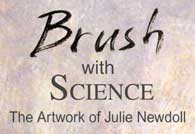

 View Portfolio |
 Inside Time |
 Shows |
 About/Contact the Artist |
DNA Centric Paintings
The paintings use DNA as a main element.
Notch Gene Figure Head, 3.5' x 5', 1993, Not For Sale
This painting began as a figure from a research paper, which looked very much like a human female figure to me. The triangular "head" is the the "notch gene" stained and photographed under a microscope. The body is the microscope image of the dna. The notch gene is found at the pelvic area of the figure. The legs of the figure were added as part of the painting.
Inspired by a figure in the paper, "Precise determination of the molecular limits of a polytene chromosome band: regulatory sequences for the Notch gene are in the interband", Rykowski MC; Parmelee SJ; Agard DA; Sedat JW, Cell 1988 Aug 12;54(4):461-72
Nanotechnology I, 20" x 24", 1992, private collection
Nanotechnology is the science of manipulating atoms to build tiny machines. These machines could be computers, chemical factories, or other types of mechanical device. It has been proposed that DNA be used as a scaffold to put tiny molecular machines onto. It has been shown that DNA can be used to form ladders and cube structures. These would make stable structures to attach tiny atomic sized machines to.
Inspired in part by the paper "Synthesis from DNA of a molecule with the connectivity of a cube", Junghuel Chen and Nadrian C. Seeman, Letters to Nature, Vol. 350, 1991.
Nanotechnology II, 3' x 4', 1992, private collection
This DNA ladder is simultaneously creating itself at one end and destroying itself at the other end. A reflection of the need for creation, destruction, and disposal of nanotechnology devices in biological systems and experimental environments. See the "Nanotechnology I" description above for more information.
Nanotechnology III, 20" x 24", 1992. Private collection.
Manjushri as topoisomerase, Untier of DNA Knots,
3' x 4', 1997. Private collection.
Topisomerase is a protein that is found inside the cells in our bodies, inside the nucleus. When a cell is in between divisions, the DNA of the cell is relaxed, looking much like a bowl of spaghetti. When it is time for the cell to divide, the DNA tightens up into its respective chromosome. Sometimes, a knot has formed in a strand of DNA, preventing it from moving where it needs to go. This protein detects such knots, cuts the DNA at the knot, unties the knot, and attaches the DNA ends back together. Manjushri is, in part, a God of knowledge. His sword cuts through untruths, and heals on the way out.
Woman Bound to DNA I, 30" x 40", 1992. $10,000, Available for purchase.
The shape of DNA contains a major groove and a minor groove. You can see the major groove in the center of the image, with a saddle shape. The figure of a woman is bound to the structure. This type of surface representation of DNA is called a "solvent accessible surface", as it indicates how close water molecules could get to the DNA. A computer generated image of DNA was first applied to the canvas using photo-emulsion, and the painting was done on top of that.
Woman Bound to DNA II, 30" x 40", 1992. $10,000, Available for purchase.
The shape of DNA contains a major groove and a minor groove. You can see the major groove in the center of the image, with an indent near the yellow sphere. The figure of a woman is bound in the major groove. The atoms of the DNA are represented by spheres. A computer generated image of DNA was first applied to the canvas using photo-emulsion, and the painting was done on top of that.